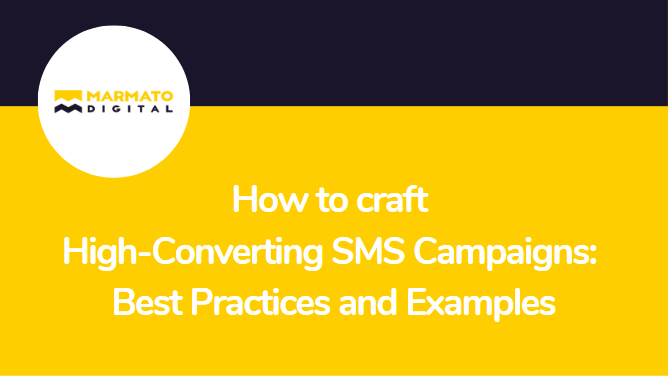For businesses, creating high-converting SMS campaigns is essential. These campaigns not only help boost sales but also strengthen customer relationships by delivering timely and relevant messages. With nearly everyone carrying a mobile phone, text messages provide a direct and personal way to reach audiences. Unlike email or social media, which can get lost in crowded inboxes or feeds, SMS cuts through the noise and grabs attention immediately. A well-crafted SMS campaign can drive quick responses, whether it’s a purchase, appointment confirmation, or feedback.

Here’s a quick look at why SMS is so effective:
– SMS messages have a 98% open rate, compared to about 20% for email.
– Most people open text messages within 3 minutes of receiving them.
– SMS click-through rates are significantly higher than other marketing channels, averaging around 19%.
With these impressive engagement rates, high-converting SMS campaigns can become a game-changer for any modern business.
Understanding SMS Campaign Fundamentals:
To run effective SMS campaigns, it’s essential to understand the core elements that make them successful. Let’s break down the fundamentals:
1. The Value of SMS in Direct Marketing:
SMS provides instant reach and incredibly high open rates. Unlike emails that may sit unread, text messages are typically opened within minutes, ensuring that your audience sees your message almost immediately. This direct line to customers makes SMS a highly effective marketing tool.
2. Importance of Compliance:
Compliance is crucial in SMS marketing. Businesses need to ensure customers give opt-in consent before sending messages. This not only protects customer privacy but also helps avoid legal issues. Following regulations like the TCPA (Telephone Consumer Protection Act) ensures that your campaigns are both ethical and compliant.
3. Choosing the Right SMS Platform:
Selecting the right SMS platform can greatly improve your ability to manage and optimize your campaigns. Look for platforms that offer integrations with your existing systems, automation for scheduling and personalization, and analytics to track the performance of your messages.
Best Practices for Crafting High-Converting SMS Campaigns:
1. Personalization:
Personalization is key to making your SMS campaigns more relevant. Tailor messages using the recipient’s name, past behavior, and preferences. Personalized texts feel more meaningful and increase the chances of engagement. For example, sending a message like “Hi [Name], we thought you’d love this offer based on your recent purchase!” can make customers feel valued.
2. Clarity and Brevity:
Keep your messages short, clear, and actionable. SMS is meant to be quick and concise, so avoid long paragraphs. Instead, deliver the main message directly, such as, “Flash Sale! Get 20% off today only.” Ensure your instructions or calls to action are easy to follow.
3. Timing and Frequency:
Sending messages at the right time is crucial. Choose a time when your audience will most likely engage, such as during lunch breaks or early evenings. Additionally, be mindful not to overwhelm customers with too many messages. A good rule is to limit SMS to 1-3 messages per week unless it’s part of a special campaign.
4. Strong Call-to-Action (CTA):
Your SMS should include a clear and compelling CTA to drive immediate action. Whether it’s “Shop Now,” “Claim Your Discount,” or “Book Your Appointment,” the CTA should prompt the customer to take quick action. Ensure the CTA is easy to spot and links to a specific action.
5. Creating Urgency:
Adding urgency to your SMS can increase response rates. Time-sensitive offers like “24-hour flash sale” or “Only 3 seats left!” create a sense of urgency, encouraging customers to act fast. Urgency taps into the fear of missing out (FOMO) and drives quicker decisions.
6. Engagement and Interaction:
Encourage two-way communication to boost customer engagement. Use SMS to send interactive polls, surveys, or requests for feedback. For example, “Reply YES if you’re interested in our new product!”.
Examples of High-Converting SMS Campaigns:
Case Study 1: Retail Industry
A fashion brand wanted to boost sales during their slow season. They created an exclusive SMS-only discount campaign, offering customers 20% off if they shopped using the code sent via text. By promoting the exclusivity of the offer—only available through SMS—the campaign drove significant engagement. Customers felt like VIPs, which led to a 30% increase in sales during the campaign period.
Case Study 2: E-commerce
An online store struggled with abandoned shopping carts. To address this, they launched an SMS campaign that sent personalized cart reminders to customers who didn’t complete their purchases. Along with the reminder, they included a 10% discount on the items left in the cart. Additionally, they used customer data to recommend related products. The result? Thanks to personalized recommendations, a 25% conversion rate on the abandoned carts and an increase in overall order value.
Case Study 3: Service-Based Business
A local salon wanted to reduce missed appointments and boost bookings. They started sending SMS appointment reminders to clients 24 hours before their scheduled visits. The reminders also allowed customers to easily reschedule or confirm their appointments by replying to the text. To increase bookings, the salon followed up with clients who hadn’t booked in a while, offering a small discount for their next appointment. These efforts led to a 40% reduction in no-shows and increased rebookings.
Common Pitfalls to Avoid in SMS Campaigns:
- Over-messaging or Spamming Customers:
Sending too many messages can overwhelm your audience and lead to them opting out of your SMS list. Customers appreciate timely and relevant information but don’t want to feel bombarded. To avoid this, limit your messaging frequency to 1-3 texts per week unless there’s a special reason for more.
- Ignoring Segmenting and Sending Generic Messages:
Sending the same message to everyone on your list is a missed opportunity. Customers expect personalized content that matches their interests. Without segmenting your audience based on behavior, preferences, or past purchases, you risk sending irrelevant messages that could cause customers to lose interest. Always tailor your messages to specific customer groups.
- Poorly Timed Messages That Disrupt Instead of Adding Value:
Timing is everything in SMS marketing. Sending texts at inconvenient times, such as late at night or during work hours, can frustrate customers. Instead, focus on sending messages when they are most likely to engage, such as mid-morning or early evening. Proper timing ensures your messages are well-received and appreciated rather than disruptive.
Tools and Technology for Optimizing SMS Campaigns:
With the right tools and data, you can continually improve your SMS marketing efforts, making them more targeted and effective.
- Overview of Automation Tools to Streamline SMS Marketing:
Automation tools make SMS marketing easier and more efficient. With these tools, you can schedule messages in advance, set up automated responses, and send personalized texts based on customer behavior.
For example, you can automate welcome messages for new subscribers or send reminders for upcoming sales. These tools also help manage contact lists, ensuring messages are sent to the right audience at the right time.
- Using Analytics to Track Performance and Adjust Strategies:
Analytics play a crucial role in optimizing your SMS campaigns. By tracking key metrics like delivery rates, click-through rates, and conversions, you can see what’s working and what needs improvement. For instance, if your open rates are high but conversions are low, you may need to tweak your call-to-action. Analyzing performance data helps you fine-tune your campaigns, ensuring better engagement and higher returns over time.
Key Takeaways:
In summary, crafting high-converting SMS campaigns requires the following key best practices:
- Personalize your messages to make them relevant to each customer.
- Keep your messages clear and brief, focusing on actionable content.
- Time your messages thoughtfully and avoid overwhelming your audience.
- Use a strong call-to-action and create urgency to drive quick responses.
- Engage customers with interactive features and make it easy for them to respond.
Staying compliant is essential—always ensure you have proper opt-in consent and follow privacy regulations. Additionally, use analytics to track your campaign performance and continually optimize your strategies based on the results.
Start optimizing your SMS campaigns today!
Looking to boost your engagement and conversions? Start optimizing your SMS campaigns today! Whether you’re driving sales, sending reminders, or gathering feedback, a well-crafted SMS strategy can make all the difference. Don’t miss out—take the first step now and see how personalized, timely messages can elevate your marketing efforts.
At Marmato Digital, we specialize in creating SMS campaigns that drive results from start to finish. Whether you’re just starting with SMS marketing or looking to improve your current strategy, our team can help. We offer a complete solution to build your campaign from scratch. Let us help you launch a successful SMS campaign and connect with your audience like never before! Contact Us now!
Subscribe to Newsletter
Get our latest blogs directly to your inbox.

